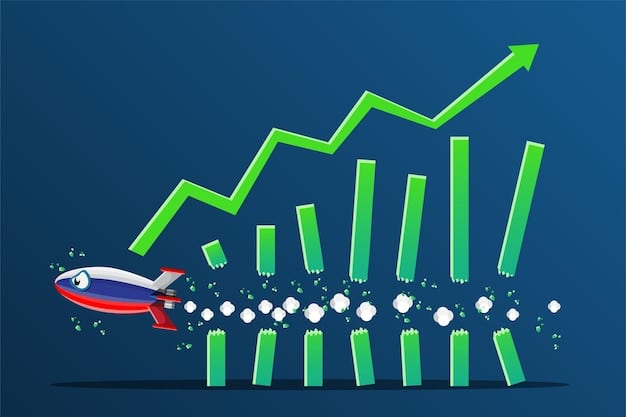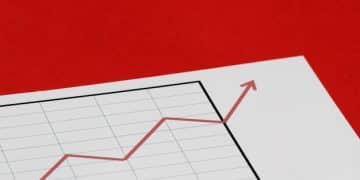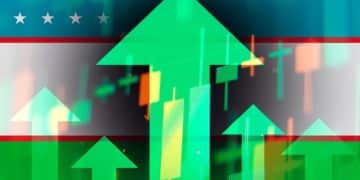Decoding Fed Meeting: January 2025 Interest Rate Hike Insights

The latest Federal Reserve meeting provides critical insights into the potential for an interest rate hike in January 2025, with economic indicators, inflation trends, and labor market data signaling adjustments to monetary policy that could impact future borrowing costs and market stability.
The financial world holds its breath as we delve into the intricate details of the latest Federal Reserve meeting, sparking intense speculation: is an interest rate hike expected in January 2025? This crucial question reverberates through markets, affecting everything from mortgages to investment portfolios. Understanding the Fed’s nuanced communications and economic projections is key to anticipating future monetary policy moves.
The Federal Reserve’s Stance: Navigating Economic Indicators
The Federal Reserve, often referred to as “the Fed,” operates with a dual mandate: to achieve maximum employment and maintain price stability. These objectives guide every decision, particularly regarding interest rates. Recent statements from Fed officials emphasize a data-dependent approach, meaning future policy decisions will hinge on incoming economic data. This makes decoding each meeting’s nuances critical for investors and consumers alike.
The economic landscape currently presents a mixed picture. While the labor market has shown resilience, concerns about persistent inflation remain. The Fed’s preferred inflation gauge, the Personal Consumption Expenditures (PCE) price index, continues to be closely monitored. Any significant deviation from the Fed’s 2% target could prompt a more hawkish stance, potentially leading to rate adjustments.
Inflationary Pressures and the Fed’s Response
Inflation has been a persistent challenge, shaped by supply chain disruptions, strong consumer demand, and geopolitical events. The Federal Reserve has repeatedly stated its commitment to bringing inflation down to its target, even if it means implementing restrictive monetary policies. The path to disinflation is rarely smooth, and policymakers are acutely aware of the risks involved in tightening too quickly or too slowly.
Factors influencing the Fed’s inflation outlook include:
- Energy prices and their volatility, which can significantly impact consumer spending.
- Wage growth and its potential to contribute to a wage-price spiral.
- Global economic conditions, affecting import and export prices.
The December 2024 meeting minutes, released in early January 2025, are anticipated to provide further clarity on how policymakers view these inflationary pressures heading into the new year. Any language suggesting a lack of confidence in disinflationary trends would be a strong signal for a potential rate hike.
The Fed’s communication strategy is designed to manage expectations and avoid market volatility. Forward guidance, while not a commitment, provides a roadmap for future policy. However, this guidance is constantly re-evaluated based on evolving economic circumstances. It’s a delicate balancing act, as missteps can have far-reaching consequences for domestic and global economies.
Labor Market Dynamics and Monetary Policy
A strong labor market is generally viewed positively, but when coupled with high inflation, it can complicate the Fed’s efforts to achieve price stability. Recent job reports have shown consistent job creation and low unemployment rates, indicating a robust economy. However, some economists argue that a tight labor market can fuel wage increases, which, if not matched by productivity gains, could contribute to inflationary pressures.
The Fed pays close attention to several key labor market indicators, beyond just the headline unemployment rate. These include:
Understanding Wage Growth and Employment Trends
Wage growth, particularly in service sectors, is a significant factor in the Fed’s calculations. If wages are rising faster than productivity, businesses may pass these increased costs on to consumers, thereby sustaining inflation. The Fed aims for a labor market that is both strong and in equilibrium, where wage growth is sustainable and consistent with its 2% inflation target.
Key labor market metrics under review:
- Average hourly earnings: indicating the pace of wage increases.
- Job openings and quit rates: reflecting labor demand and worker confidence.
- Labor force participation rate: showing the overall health and size of the workforce.
A persistent tightness in the labor market, characterized by high demand for workers and limited supply, could sway the Fed towards a more aggressive stance, including the possibility of a rate hike. Conversely, any signs of a significant slowdown in employment or an increase in the unemployment rate might lead the Fed to pause or even consider rate cuts, depending on the inflation outlook.
The interaction between the labor market and inflation is complex. A rapidly cooling labor market could help alleviate inflationary pressures by reducing consumer demand and wage growth. However, a sudden spike in unemployment could also signal a broader economic downturn. The Fed’s objective is toengineer a “soft landing,” where inflation is tamed without triggering a recession, a task that requires careful calibration of monetary policy.

Global Economic Headwinds and Their Impact on the Fed
The U.S. economy does not operate in a vacuum. Global economic conditions, including geopolitical events, trade policies, and the economic performance of major trading partners, significantly influence the Federal Reserve’s decisions. A global slowdown, for instance, could dampen demand for U.S. exports, potentially impacting domestic economic growth and employment. Conversely, robust global growth could increase demand and contribute to inflationary pressures.
Geopolitical Tensions and Supply Chain Resilience
Ongoing geopolitical tensions, particularly those affecting energy markets and critical supply chains, introduce a layer of unpredictability. Disruptions in the supply of key commodities can lead to price spikes, which propagate through the global economy and inevitably affect U.S. inflation. The Fed must consider these external factors when assessing the domestic economic outlook and formulating policy responses.
Global factors influencing Fed policy:
- Fluctuations in global energy and commodity prices.
- Trade relations and tariffs, impacting import costs and business investment.
- Economic health of major trading partners, like China and the Eurozone.
A stronger U.S. dollar, often a consequence of higher domestic interest rates, can make U.S. goods more expensive for international buyers, potentially hurting exports. At the same time, a strong dollar makes imports cheaper, which can help mitigate domestic inflation. This dynamic creates a complex set of trade-offs for the Fed, as it seeks to balance domestic objectives with global economic realities.
The interconnectedness of global financial markets also means that policy decisions by other central banks can influence the Fed’s stance. For example, if other major central banks are tightening monetary policy, it might reduce the need for the Fed to act as aggressively. Conversely, if they are easing, it could put upward pressure on the dollar and increase the risk of imported inflation. This intricate dance of global monetary policy is a constant consideration for Federal Reserve officials.
Analyzing the December 2024 Meeting Minutes
While the Federal Reserve’s meetings are private, the minutes released shortly after provide invaluable insights into the discussions, debates, and economic assessments of the Federal Open Market Committee (FOMC) members. These minutes often reveal the differing perspectives among policymakers and shed light on the factors that weighed most heavily in their decisions. The December 2024 minutes, released in early January 2025, will be particularly scrutinized for any hints regarding the interest rate hike expected in January 2025.
Key Themes and Discussions from the Meeting
Analysts will be poring over phrases and subtle shifts in language for clues about the Fed’s future trajectory. Look for discussions on the “neutral rate” of interest, the long-term sustainable level that neither stimulates nor constrains economic growth. Any adjustments to this estimated rate could signal a fundamental shift in how the Fed views the economy’s capacity. Additionally, comments on “financial conditions” will be important, as the Fed considers how its policies are transmitted through markets to the broader economy.
Aspects to watch for in the December 2024 minutes:
- Discussions on the path of inflation and whether it’s decelerating as anticipated.
- Assessments of potential risks to economic growth, both domestic and global.
- Dissenting votes or nuanced opinions among FOMC members regarding future rate adjustments.
The minutes often include projections for key economic variables such as GDP growth, unemployment, and inflation. Any revisions to these projections can indicate a change in the Fed’s outlook and, consequently, its policy biases. If the median projection for inflation in late 2024 or early 2025 is higher than previous forecasts, it would lend credence to the idea of an early 2025 rate hike.
Furthermore, the minutes might delve into specific sectorial performances, such as the housing market or manufacturing, to understand the broader economic health. Weakness in certain sectors, if severe enough, could prompt a more cautious approach. Conversely, unexpected strength could reinforce the need for continued vigilance against inflation. The minutes are not just a historical record; they are a forward-looking document, shaping market expectations for months to come.
Market Expectations and Investor Sentiment for Early 2025
Market participants constantly attempt to “front-run” the Fed, adjusting their positions based on anticipated policy changes. Futures markets, particularly the federal funds futures, provide a real-time gauge of market expectations for future interest rate moves. As of late 2024, these markets are already pricing in a certain probability for an interest rate hike in January 2025, but these probabilities are highly fluid and react swiftly to new economic data and Fed commentary.
How Markets Price in Future Rate Adjustments
The pricing mechanism in futures markets reflects the collective wisdom and risk assessments of a vast number of traders and institutions. A higher probability assigned to a rate hike typically means that investors are preparing for tighter monetary conditions, which can lead to shifts in asset allocations, bond yields, and currency valuations. Conversely, a lower probability might suggest expectations of a more accommodative stance.
Factors influencing market expectations:
- Official statements and speeches from Federal Reserve officials.
- Economic data releases, such as CPI, PPI, and employment reports.
- Geopolitical developments and their potential impact on economic stability.
Investor sentiment also plays a crucial role. If major financial institutions, economists, and influential analysts begin to converge on a particular outlook for Fed policy, it can create a self-fulfilling prophecy, as markets adjust in anticipation. However, the Fed is acutely aware of this dynamic and often tries to avoid surprising the markets too dramatically, preferring a more predictable, data-driven path.
The bond market, in particular, is highly sensitive to expectations of future interest rates. Rising yields on Treasury bonds can signal that investors expect higher rates, reflecting concerns about inflation or anticipating further Fed tightening. For equity markets, higher rates can increase borrowing costs for companies, potentially dampening corporate earnings and making bonds more attractive relative to stocks. Therefore, any strong signal from the Fed, or the data, will be immediately reflected across various asset classes.

Potential Scenarios for January 2025 and Beyond
Forecasting the Federal Reserve’s precise actions is challenging, given their data-dependent approach. However, based on current economic trends and Fed communications, we can outline several plausible scenarios for January 2025 and the subsequent months. Each scenario carries different implications for the economy and financial markets.
Scenario 1: An Interest Rate Hike Occurs
This scenario would likely be triggered by persistent inflation above the Fed’s target, coupled with a robust labor market. If core inflation metrics show no signs of sustained deceleration and wage growth remains strong, the Fed might conclude that further tightening is necessary to anchor inflation expectations. A January hike would signal the Fed’s unwavering commitment to price stability.
Implications of a rate hike:
- Higher borrowing costs for consumers and businesses, impacting mortgages, loans, and credit cards.
- Potential strengthening of the U.S. dollar, affecting international trade.
- Increased volatility in equity and bond markets as investors adjust to new conditions.
Such a move could be preceded by a series of hawkish statements from Fed officials in late 2024, preparing the markets for the possibility. Bond yields would likely rise further, and growth stocks, which are more sensitive to borrowing costs, might face headwinds. The Fed would weigh the risk of slowing economic growth against the imperative of taming inflation.
Scenario 2: The Fed Maintains Current Rates
This outcome would occur if economic data in late 2024 and early 2025 indicates a significant cooling in inflation without a sharp deterioration in the labor market. If supply chain issues resolve faster than anticipated, energy prices stabilize, and consumer demand moderates naturally, the Fed might feel comfortable pausing rate adjustments. This would represent a “wait-and-see” approach, allowing previous rate hikes to fully transmit through the economy.
Implications of maintaining rates:
- Relative stability in borrowing costs, offering some relief to borrowers.
- Potentially positive sentiment in equity markets, as recession fears might ease.
- The dollar’s value could stabilize or weaken slightly against major currencies.
A pause would not necessarily mean an end to the tightening cycle, but rather a temporary halt to assess the effectiveness of prior actions. The Fed would likely reiterate its data-dependent stance, keeping the door open for future adjustments if economic conditions warrant. This scenario would be favorable for sectors sensitive to interest rates, such as real estate.
Scenario 3: The Fed Hints at a Future Cut
While less likely given the current inflationary environment, this scenario could emerge if the economy experiences an unexpected and significant downturn, leading to a sharp rise in unemployment and a rapid deceleration of inflation well below the 2% target. In such a deflationary environment, the Fed might signal a shift towards easing monetary policy.
Implications of hinting at a cut:
- Expectations of lower borrowing costs in the future, stimulating economic activity.
- Potential weakening of the U.S. dollar, boosting exports.
- Rallies in equity and bond markets, as investors anticipate a more accommodative Fed.
This would be a drastic shift from the current trajectory and would require compelling evidence of severe economic weakness. The Fed would prioritize supporting economic growth and job creation in such a situation. While not the primary expectation for January 2025, it remains a tail risk that policymakers must consider in their long-term planning.
The Federal Reserve’s decisions are complex and multifaceted, reflecting a careful balance of economic goals and potential risks. The January 2025 meeting, or the minutes preceding it, will undoubtedly provide crucial signals about which of these scenarios is most likely to unfold. Adapting investment and financial strategies to these possibilities is paramount for navigating the evolving economic landscape.
| Key Point | Brief Description |
|---|---|
| 📊 Fed’s Dual Mandate Decision | The Federal Reserve balances maximum employment and price stability to guide rate decisions. |
| 📈 Inflationary Pressures | Persistent inflation above target could lead to further rate hikes. |
| 💼 Labor Market Strength | A tight labor market and wage growth factor into the Fed’s monetary policy. |
| 🌍 Global Economic Headwinds | Geopolitical events and global slowdowns influence the Fed’s stance. |
Frequently Asked Questions About the Fed Meeting
The Federal Reserve considers an interest rate hike primarily to combat persistent inflation that remains above its 2% target. If economic data, especially related to consumer prices and wage growth, suggests that inflation is not cooling adequately, the Fed might raise rates to slow down economic activity and reduce price pressures. A robust labor market also plays a role in this decision-making process.
The Fed closely monitors a wide array of economic indicators. Crucial among these are the Personal Consumption Expenditures (PCE) price index for inflation, various labor market statistics like unemployment rates and wage growth, and broader economic activity measures such as GDP growth and retail sales. Global economic conditions and financial stability metrics also heavily influence their policy considerations.
An interest rate hike significantly impacts average Americans by making borrowing more expensive. This translates to higher interest rates on mortgages, car loans, credit cards, and business credit. While it aims to curb inflation, it can also slow economic growth, potentially affecting job creation and consumer spending. Savers, however, might see higher returns on their deposits and fixed-income investments.
Absolutely. Geopolitical events can have a profound impact on the global economy, influencing energy prices, supply chains, and overall market stability. The Fed takes these external factors into account as they can significantly affect U.S. inflation and economic growth. For example, disruptions due to conflicts or trade disputes can lead to commodity price spikes, necessitating a review of monetary policy.
The December 2024 meeting minutes, released in early January 2025, are highly significant as they offer detailed insights into the Federal Open Market Committee’s (FOMC) internal discussions, economic forecasts, and policy biases. These minutes often reveal the rationale behind their decisions and any dissenting opinions, providing valuable clues to the market about the future direction of monetary policy and the likelihood of upcoming rate changes.
Conclusion
The question of whether an interest rate hike is expected in January 2025 remains at the forefront of economic discussions. The Federal Reserve’s commitment to its dual mandate of maximum employment and price stability will continue to guide its decisions, heavily influenced by incoming data on inflation, the labor market, and global economic conditions. While the path ahead is uncertain, careful analysis of Fed communications and economic indicators will be crucial for understanding and adapting to the evolving monetary policy landscape. The financial community will be closely watching January’s economic releases and the minutes from the December 2024 meeting for the clearest signals yet on the Fed’s next steps.





